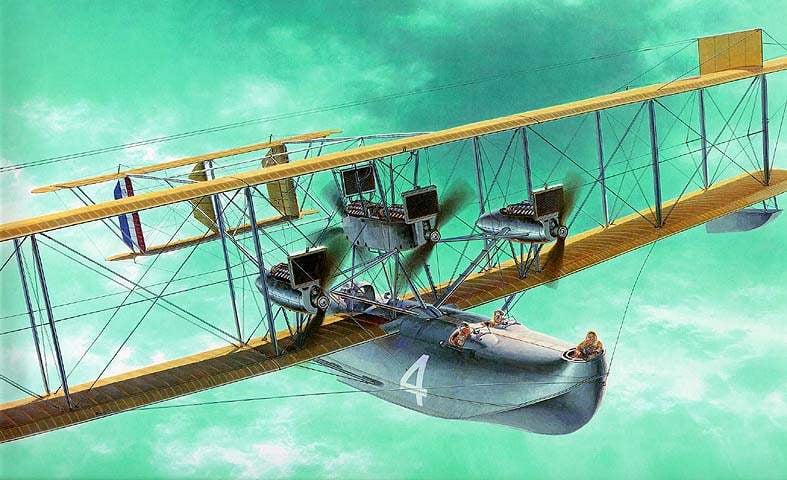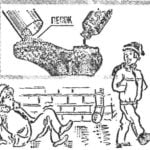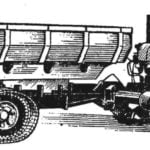 Patrol flying boat NC-4. During the First world war, the only transport artery between America and Europe was a sea passage across the Atlantic. This way for the transport ships was quite a long and risky as the oceans they lay in wait for German submarines and warships.
Patrol flying boat NC-4. During the First world war, the only transport artery between America and Europe was a sea passage across the Atlantic. This way for the transport ships was quite a long and risky as the oceans they lay in wait for German submarines and warships.
Faster and more secure way ran over the water — through the air. He seemed very real — the success of the aircraft industry are allowed to create a flying boat long range and carrying capacity. The most ardent proponent of this idea was Admiral Taylor of the weapons division of the us Navy. The Admiral managed to interest the U.S. government, and in December 1917 he received the money for the construction of a series of large flying boats, capable to fly the Atlantic.
Designing and construction of transport flying boats instructed the firm Curtiss. Its owner, the famous Creator of seaplanes-Glenn Curtiss, enjoyed great prestige among the military. In 1910 held the takeoffs and landings of its first seaplane. And in 1914, the firm has built a Curtiss twin-engined flying boat H-12 “Large America,” for flights across the Atlantic.
Unfortunately, this flying boat to make such a flight was not possible: the organizers prevented the First world war. But these planes were taken into service by great Britain. Improved captain John Port (the flying boat was reinforced case), they were built large enough time series to 1918, it was made 96 machines. Their main task was the patrolling of the North sea in search of German ships and submarines. The crew consisted of four people. Armament consisted of four machine guns and 200 kg of bombs.
A new transatlantic flying boat Certosa was built in a very short time. The first prototype with the designation NC-1 (Navy Curtiss 1) took to the air in October 1918, less than a year after receiving the order. The airship was one of the greatest American aircraft of the time the Fuselage length of 16.8 meters crowned durable box biplane wings with a maximum wingspan of 38.4 meters. Takeoff weight was over 10,000 lbs. To lift in the air, there were three 400-HP LIBERTY 12 engine with a pusher propeller.

The launching of a flying boat NC-4
It was planned to release several variants of the aircraft: transport, reconnaissance and bomber.
The last two were distinguished by the presence of small arms in the Navigator in the nose of the fuselage and the mechanics — in the stern. Flight testing ended on 11 November 1918. However, the Navy canceled my order for a flying boat NC: date of completion of flight tests of NC-1 coincided with the date of the German surrender, and the aircraft for rapid deployment of troops to Europe was no longer needed.
The mastermind of a TRANS-Atlantic plane Admiral Taylor could not accept the cessation of work on the plane dz and in December 1918, stated: “If he will not fight, let them, at least, will fly the Atlantic”. This phrase became the motto of the now research campaign flights across the Atlantic ocean. In addition, aircraft manufacturers are attracted by the opportunity of getting a big cash prize of £ 10,000, established by the British newspaper Daily Mail for a flight across the ocean.
The direction of flights in the initial conditions of receiving a prize was not mentioned — it was possible to fly from America to England and Vice versa. The organizers chose the first option, which was considered safer and more economical, since in this direction most of the winds blow.
For detailed preparation of the expedition in the Maritime Ministry of the U.S. was established a special Department and allocation of funds. In accordance with the plan flight was held on the route: new York (United States) — Halifax (Canada) — St Johns (Canada, Newfoundland island) — Azores— Lisbon (Portugal) Plymouth (UK). On the route of flight must have been fifty ships of war to communication, rescue and weather reconnaissance Total length of the route amounted to nearly 4000 km.
The scale of the operation was so huge that the cash prize of the newspaper the Daily Mail was not seriously considered. When the editors (probably not wanting to pay) has changed the conditions of receiving the prize, clearly defining the direction of flights from the UK to the US, no-one paid attention.
Factories Certosa ended the construction of the three NC planes with indices 2, 3 and 4. The last of them was launched on 30 April 1919. Compared to the original project in 1918 to the design of all four boats have made significant changes. The aircraft has set yet another (fourth) engine under the scheme in tandem with the average. Besides, to increase efficiency propeller installation pusher propellers were replaced by nagging. Due to the speed of flight reached 148 km/h. in addition, the hydroplanes set radio stations, devices for flying out of sight of land and floodlights for night flights. Takeoff weight of cars has increased to 12 300 kg, fuel capacity amounted to 6,600 L.
When conducting the flight test, the upgraded boat NC-1 was in bad weather and was damaged during landing. Mainly affected the plane of the wings. To repair the car had to use nodes not yet flying boat NC-2. By the way, in the future, the aircraft NC-2 was not restored, and saw it as a parts kit.
Thus, after appropriate modifications and test for the flight across the Atlantic has developed three machines — NC-1, NC-3 and NC-4. The crew commanders appointed experienced pilots of the fleet — Towers, I., P. Bellinger and A. reed. The flight was scheduled for the first days of may, hoping to get to the full moon, as part of the flight was to take place at night.
The boat was moved to the starting point at the base of Rockaway, located near new York city. 4 may there was an unpleasant event that has detained the beginning of the flight — at 2 a.m. in the hangar of the base there was a fire which damaged one of the boats. Everything deteriorated weather All these circumstances forced the organizers to postpone the departure on may 8.


Flying boat NAVY-CURTISS (NC-4):
1 — rocking of the Elevator; 2 — upper tail boom; 3 — rocking Aileron; 4 — wing front; 5 – radiator; 6 — the rear wing strut; 7 – brace the tail beam; 8 — thrust Elevator control; 9 — an intermediate transverse section of the tail boom; 10 — control rod rudder 11 — lower tail boom; 12 — two-blade wooden screw; 13 — visor of the cockpit; 14 the hood of the engine; 15 — vehicles; 16 — braces corneal compensator; 17 — brace rocking elevators; 18 — clock brace of elevators; 19 — wing struts; 20 stands wing float; 21 — redan: 22 — the wing float; 23 — front center section; 24 — radiator pusher engine; 25 — back front center section; 26 — back front Central engine; 27 — brace Central engines; 28 — front Central engine; 29 — fairing side of the engine; 30 — back front side of the engine; 31 — front side of the engine; 32 — traction control Aileron; 33 — rib of the upper wing; 34 — brace aerodynamic ridge; 35 — brace rocking Aileron; 36-inner wing braces; 37, the outer braces of the wing; 38 — rib of the lower wing; 39 — brace rudder; 40 — brace stabilizer; 41 — brace rudder; 42 — brace stabilizer; 43 — Central stabilizer; 44 — rib stabilizer; 45 — seat crew commander; 46 — working place of the Navigator; 47 the copilot’s seat; a 48 — Aileron; 49 — upper stabilizer; 50 — horn compensation; 51 —steering wheel height; 52 left Kiel; 53 — lower stabilizer; 54 Central keel; 55 — right keel; 56 — lateral struts of engines: 57 — oil tanks; 58 — end of the wing brace
In this day, at 10 o’clock in the morning local time (14.00 GMT), the pilots took their seats, and the aircraft rose into the air. The crews of NC-1 and NC-4 consisted of 6 people, and the NC-3 — of 7 people. The expedition was accompanied journalists, government officials and relatives of crew members.
To Newfoundland flew only two boats, N04 made an emergency landing because of the broken screw. To repair the propeller, the crew was helped by experts from a specially equipped ship “Baltimore.” On 15 may, the boat caught up with the other participants of the trip. After lunch on 16 may, the whole group continued its flight, taking the Azores. To reach them it was assumed at the beginning of the next day. On the route of flight they were accompanied by 23 destroyers, prepared to provide pilots any help and support.
The leading plane was NC-3. By nightfall, the aircraft has lost visual contact between them. Left alone, NC-3 lost orientation after the passage of the destroyer, No. 17. After 13 hours of flight in total darkness the crew of the tower decided to put the boat to navigate and at the same time check its seaworthiness. The weather forecast did not promise an easy landing: it was pouring rain and a strong wind was blowing, the height of the waves reached several meters. According to the calculations of the Navigator, to the Azores remained at approximately 73 miles.
During the landing the hull of the boat was damaged but the engines were working, and the car began to move East. Waves gradually destroyed the plane was soon broken wing and tail feathers. Through the formed plywood in the bottom of the boat the cracks are beginning to enter the water. The crew bravely fought for the survival of the ship. Only after 52 hours of exhausted pilots noticed a land. During this time the boat was at sea 405 km.
NC-1 safely to the destroyer No. 18, and then flew into the fog and lost. May 17, at 12.10 GMT the commander of the NC-1 Billiger decided to sit on the water. To the Azores was about 324 km. And the landing was unsuccessful: the resulting damage did not allow the boat to rise again into the air. In the evening of the same day the drifting boat spotted on Board the destroyer “ion”. The crew moved aboard the ship, and the plane was taken in tow. However, the fragile design of the aircraft did not survive towing in heavy seas, and NC-1 soon sank.

Boat NC4 in flight
The most fortunate were the crew of NC-4. After passage of the 15th destroyer pilots got into the fog, but it was steadily chosen course. Blindly they went from one vehicle to another. Solid fog is not allowed to see the pilots of torpedo boats Nos. 17, 18, 19 and 20, but radio contact with the ships crew were lost. Commander Reid took the only right decision— to climb.
Once the altimeter showed 1000 meters, the car jumped out of the fog and found himself in the clear sky. The morale of the crew got up. Navigating by the stars and compass, the NC-4 successfully moved to the East to the Azores Islands. Destroyer No. 21 was told about the visibility to 10 miles. After some time in tears misty shroud of the crew noticed the rocky shores of Faial. May 17, at 13.25 UTC, the pilots landed the aircraft at the port of Horta and left there, waiting for better weather. May 20 the NC-4 flew to the island of são Miguel in the port of Ponta Delgada, where for three days, waited in vain for the aircraft NC1 and NC-3.
May 27 at 10.18 GMT NC4 headed for the coast of Portugal. On the route were 14 destroyers of the us Navy. Small worsening of the weather, which led to the loss of visual contact with vehicles No. 3 and No. 10, did not have any impact on the outcome of the flight. In 20.01 GMT, the hull of the boat touched the water in the Harbor of Lisbon. For the first time the Atlantic ocean was crossed by air!
After three days of rest the crew of the NC-4 flew to the UK, and may 31, 1919, the plane landed at Plymouth. The total distance is 3936 km has been covered in 24 days; in the air the airplane was 52 hours 31 minutes. Average speed of flight was 138,89 km/h crew: commander A. Reid, the pilots Moan and E. V. Hinton, radioman Rodd, reserve pilot-mechanic D. Brice and the mechanic E. Roades.
Unfortunately, this flight was quickly forgotten, which contributed to the transatlantic flight of the British in may — June 1919, on the bomber “Vimi” the firm Vickers. This flight took place at more than twice the short route (Ireland — Newfoundland) and lasted about 12 hours.
The history of the NC boats were not over. In subsequent years we have built six planes with successive numbers. Boat NC-5 and NC-6 had three engines, and all the rest — four In 1922, the machine received the designation P2N, and for some time served as patrol aircraft.
Design of the aircraft, the Navy Curtiss NC-4
The plane was a four-engine flying boat solid wood construction beam type. It was designed as a long-range patrol aircraft, which could also be used for transport of cargo on transatlantic routes. The crew consisted of six people: the pilot (crew commander), copilot, Navigator, radio operator and two flight engineer.
The fuselage of the aircraft was carried out in odnorodnoi boats of wooden construction, where the beams attached to the tail unit. Power set of the corps consisted of 36 frames, and longerons and stringers. To provide buoyancy at the damage to the inner volume of the shell was divided into sealed compartments.
Functionally, the hull had three parts: the nose, center and aft. The first contained the cockpit and the workplace Navigator with a set of navigation equipment. The pilots were near, while the commander sat on the left and copilot on the right.
Instrumentation of the cockpit was the most modern for its time. In it consisted of the control devices of engines, piloting and navigation. All this allowed to perform flights day and night, in VFR and IFR weather conditions, out of sight of land.
Behind the pilot chairs were the workplace of the operator and resting place for two crew members.
Second, the Central part of the fuselage housed four of the fuel tank. Each of them could feed or just your engine, or simultaneously all four engines; in the latter case one of the tanks become expendable. Switching tanks on various modes of fuel injection were performed by the flight engineers. Duties included working with manual back-up pump fuel.
In the third, the rear fuselage were the jobs of engineers. There was a rescue equipment and a kit to perform a simple repair of the aircraft.
Inside the case on the sides of the boat passed control cables, control surfaces. The hull plating and plywood. At the top of the aft part is attached to the bottom beam of the removal of the tail.
Wings of solid wood. Both the upper and the lower wing had the same trichlorsilane design. Technologically each wing was divided into three sections: center section, right and left console. Biplane box was formed by three pairs of profiled hardwood stands and cables-braces. The spars of the wing — box type; ribs of wood, glued. In the area of the end ribs of the center section is attached to the strut of the right and left engines, and the struts of the lower wing. The wing skin fabric. The upper surface of the lower wing center section trimmed with plywood, allowing technicians to move around the wing for inspection of engines.
Below, on the right and left consoles of the lower wing at the front fixed support floats providing lateral stability of the boat on the water.
Ailerons with horn compensation is established only on the upper wing. Control of the Aileron cable. Tail biplane design included upper and lower stabilizers with elevators and three keel. Rudders were installed only on the external fins.
The design of the tail — solid wood; power set consisted of three spars and ribs. The covering of feathers and fabric. To ensure the synchronization of the deflection of the rudders latest connected sync cables. Attached to the tail unit into three beams, one of which went to hull, and the other two to the upper wing.

The power plant consisted of four engines LIBERTY 12 power 400 HP Three motor equipped with pulling propellers and one pusher. Propellers two-blade, wooden, constant pitch. The engines were controlled from knobs in the cockpit (the pilots). Control devices of the engines were only on the panel of the crew commander.
The oil tanks of the Central tandem engines are installed between the engines in nacelles, and the oil tanks of the right and left engines — fairings behind the engines oil Cooler — head-type, they were fixed in front of the engines. A tandem oil cooler rear engine was raised over the motor and placed in the airflow to provide better cooling.
Performance characteristics NC-4
Length, m…………………………………………..20,76
Height, m………………………………………….7,48
Wing span, m………………………………..38,4
Empty weight, kg……………………………….7143
Maximum takeoff weight, kg………12 323
Maximum speed, km/h……………..148
Ceiling, m………………………………………..1500
Flight range, km…………………………2380
N. Food reserve was, A. CHECHIN



